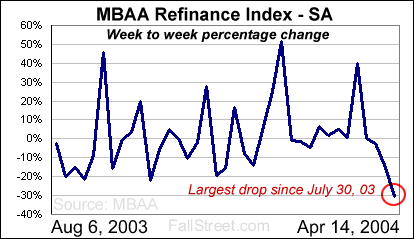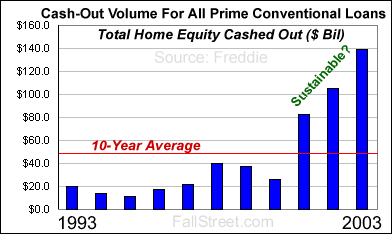April 14, 2004
The Unwind May Not Last Long, But It Will Be Painful
On April 2 a stronger than expected payrolls number jolted the bond markets. Yesterday a stronger than expected retail sales report slammed bonds (and stocks), and this morning a stronger than expected reading on consumer prices is causing more havoc in the financial markets. Suffice to say, the so called ‘reflation’ investment approach – meaning short the US dollar and buy stocks and precious metals – is, for the moment, dead.
Everyone knew that the reflation trades would eventually become overextended and an adjustment would have to be made. To be sure, stock prices cannot go straight up and bond yields straight down forever. However, the immediate threat – now that the Fed must try to buy back some ammo by playing its rate hike card – is that the adjustment phase demolishes the economic/stock market recovery that took more than a year to build up.
To see how immediate the impact of rising interest rates have on the US economy, consider the activity in the refi market (which has been helping support consumer spending since the recession ended). The big question is, if refi activity continues to cool off will another driver (jobs growth?) permanently emerge to pick up the slack?
 |
Why are the refi statistics important? Because like mortgage activity and housing prices, refi activity is influenced by interest rates. If the most recent jump in interest rates – which is pushing mortgage rates higher – is crushing refi business other related statistics will undoubtedly follow. For an example of why this is potentially bad news look at cash-outs: even though it may be wishful thinking to believe that cash-out volumes will remain above the 10-year average during a rising interest rate environment, an average year for cash-out volumes would mean nearly $100 billion less in the consumer’s pocket.
 |
Suffice it to say, these types of statistics – or statistics that suggest lower interest rates were only temporarily helping fuel the economic recovery - are numerous.
Stocks at risk, and cash is only haven
G&K Service’s margins are declining, the company is reporting no employment growth within its customer base, and GKSRA stock is up more than 50% since last year. Notwithstanding the company’s internal growth plans, the fact is that the G&K has yet to materially benefit from what has been an historically strong turnaround in the US economy. Why has G&K’s stock price rallied? Because of the excitement of reflation….
It may only take a few months for the Fed to gain back some much needed ammo. However, it could also be the case that the US economy will be unable to thrive inside of a higher interest rate environment, and that we are entering a prolonged period of interest rate uncertainty. Whatever the case may be, higher interest rates are already having an impact on the financial markets, and there are too many G&K’s to mention (or stock prices that have outrun the fundamentals of the underlying company).
Assuming the temporarily stimulated fundamentals of US companies will be unable to readily catch up to stock prices is why the conclusion of ‘pain’ rings loudly. To be sure, a company like G&K would only seem to be reasonably priced if its stock price plunges or the company dramatically improves operations. It is much easier to envision falling stock prices than a long-term economic expansion in the face of rising interest rates.
In short, with most stocks unattractive, bonds a gamble, and precious metals taking cues from the dollar, cash, for the moment, is king. Cash will remain king until the painful unwind of ‘short the US dollar and buy stocks and precious metals’ is eradicated.